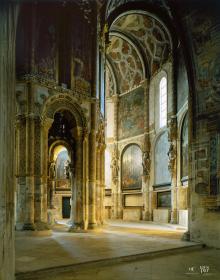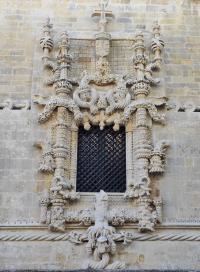- HOME
- MONUMENT
- Convent of Christ
- History
- Architecture
- Personalities
- King Afonso Henriques
- D. Gualdim Pais
- King Dinis
- King John I
- D. Lopo Dias de Sousa
- King Duarte
- Prince D. Henrique (Henry
- King John II (1455 - 1495
- King Manuel I (1469 - 152
- Diogo de Arruda
- João de Castilho
- Jorge Afonso
- Olivier de Gand
- King John III (1502 - 155
- Diogo de Torralva
- Friar Anthony of Lisbon
- Baltazar de Faria
- Filipe Terzi
- Philippine Dinasty
- King Philip II of Spain
- King John IV
- Domingos Serrão
- Queen Mary II
- Prince Fernando
- Costa Cabral
- Artisans and Artists
- Intangible Heritage
- Related Heritage
- Glossary
- VISIT OUR MONUMENT
- HERITAGE LEARNING
- TOMAR
- MONASTERIES ROUTE

Charola
The Charola was the Knight´s private oratorium within the fortress. Its typology was similar to the byzantine churches which integrated the Romanesque with the Crusades movement.
It has as its base the design which develops around a central space in which the Templar rotunda had the shape of an octagonal prism - also known as tambor - which unfolded in sixteen sides vested in the ambulatory and thus closing the volumetry of the building. Finished in 1190, the Charola had its entrance facing east. King Manuel I´s works to extend the church outside the castle walls changed it to become south facing.
With the castle already as headquarters for the knights of Christ, Infante D. Henrique, governor and keeper of the Order between 1420 and 1460, will be responsible for the first changes to the Templar rotunda. These changes had the objective of giving it the spatial requirements necessary for the liturgical functions of the contemplative friars which he had introduced into the Militia of Christ. Two large windows were opened in the face of the ambulatory facing west and a wooden structure built for the choir in its brickwork. At the same time, four chapels on the ambulatory walls were built, facing, respectively, northeast, and northwest, southeast and southwest. In the remaining directions altars circling the ambulatory were erected. This extension of the liturgical space by King Manuel I resulted in the removal of the woodworks and surrounding support of the large windows installed by the Infante and are replaced to a triumphal arch which articulates the Templar space with the Manueline nave. The Charola will now function in the Main Chapel of the new conventual church. It will be enriched with sacred art including sculpture, wood and leather painting, mural paintings and pargets. Recently, there has been an important discovery - Manueline paintings in the vaulted ceiling of the ambulatory which had been covered in lime after the 1755´s earthquake. Its restoration took place between 1987 and 2014.
SERVICES - ACTIVITIES



